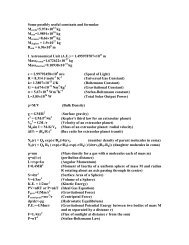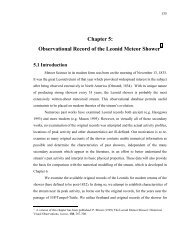Edwards W.N., Brown P.G., Weryk R.J., ReVelle D.O.
Edwards W.N., Brown P.G., Weryk R.J., ReVelle D.O.
Edwards W.N., Brown P.G., Weryk R.J., ReVelle D.O.
You also want an ePaper? Increase the reach of your titles
YUMPU automatically turns print PDFs into web optimized ePapers that Google loves.
228 W. N. <strong>Edwards</strong> et al.<br />
observations fit with ELFO recording the arrival of weakly non-linear shock waves. Yet<br />
only when using a realistic vertically inhomogeneous atmosphere can the theory reasonably<br />
fit the overpressure observations. Isothermal atmosphere assumptions underestimate<br />
this amplitude by at least two orders of magnitude. Such a significant finding implies that<br />
the kinetic energy (E)–overpressure relationship (Ceplecha et al. 1998),<br />
E ¼ 11:5pqmR 03 pffiffiffiffiffiffiffiffiffi 4 C<br />
Dp pZpg<br />
3 S<br />
ð2Þ<br />
V<br />
first introduced by (<strong>Brown</strong> et al. 1996) and based upon these isothermal assumptions, will<br />
significantly over estimate meteoroid kinetic energy by orders of magnitude when observed<br />
Dp are input. Note that in (2) and later (3), qm, is the meteoroid density; V, meteoroid<br />
velocity; R0 is the range from observation point to the meteor and pZ and pg are the ambient<br />
pressures at the source height and ground, respectively. Such over-the-top and/or highly<br />
variable estimates of kinetic energy have been commonly reported when applying this<br />
formula to real data (e.g. <strong>Brown</strong> et al. 1996; <strong>ReVelle</strong> and Whitaker 1999; <strong>Brown</strong> et al.<br />
2007). In contrast, the equivalent kinetic energy–period (s) relationship (Ceplecha et al.<br />
1998),<br />
E ¼ p<br />
12<br />
s<br />
1:579<br />
4 q mC 7 S<br />
VR 0<br />
also based upon isothermal assumptions, should produce more robust energy estimates than<br />
overpressure despite the severe dependence on the sound speed, C S. This is due in part to<br />
the relative insensitivity of the period (in the current theory) to the atmospheric model<br />
chosen (<strong>ReVelle</strong> 1974, 1976) and because the speed of sound varies relatively little<br />
(305 m/s ± 15%) between *120 and 50 km altitude, where most of the meteor infrasound<br />
observed so far is generated (Table 1).<br />
As the current multi-instrumental campaign to observe infrasound from these smaller,<br />
more common, regional meteors continues, it will finally be possible to explore the<br />
infrasound and hyper-velocity meteoroid relationship both quantitatively and statistically,<br />
placing limits on current theory and potentially revising our current understanding of the<br />
shock mechanism at the source. Additionally, further work on ballistic observations should<br />
also provide another method to constrain other poorly known quantities in hyper-velocity<br />
meteoroid-atmosphere interactions such as luminous efficiency and bulk density through<br />
use of infrasonic energy estimates and infrasonic mass in tandem with electro-optical<br />
observations. This should be possible for ballistic observations since, due to cylindrical<br />
propagation, ballistic waves originate along a finite section of the meteor trail and thus be<br />
related to the physical properties of the meteoroid (mass/size) along that section. Infrasound<br />
in meteor science is now steadily progressing from its early theoretical confines to<br />
both observational and practical applications.<br />
References<br />
J. Borovička, The comparison of two methods of determining meteor trajectories from photographs. Bull.<br />
Astron. Inst. Czech. 41, 391–396 (1990)<br />
P. <strong>Brown</strong>, A.R. Hildebrand, D.W.E. Green, D. Pagé, C. Jacobs, D. <strong>ReVelle</strong>, E. Tagliaferri, J. Wacker,<br />
B. Wetmiller, The fall of the St-Robert meteorite. Meteorit. Planet. Sci. 31, 502–517 (1996)<br />
P.G. <strong>Brown</strong>, R.W. Whitaker, D.O. <strong>ReVelle</strong>, E. Tagliaferri, Multi-station infrasonic observations of two<br />
bolides: signal interpretation and implications for monitoring of atmospheric explosions. Geophys. Res.<br />
Lett. 29 (2002). doi: 10.1029/2001GL013778<br />
123<br />
ð3Þ





